When you’re shopping for cold-weather equipment, you want to be sure you have the right tools for the job. After all, proper preparation for the conditions can be the difference between another fun adventure and having to be rescued. This is especially true of your choice of footwear traction, which will either help or hinder you as you try to navigate the snowy and icy terrain. Typically, your choices will fall into three categories: microspikes, crampons, and snowshoes (skis too, but that’s a different article).
Though they serve similar purposes, they’re not the same by any means, and shouldn’t be used interchangeably. On that note, we’ve decided to clear up a bit of the confusion, so if you’re a bit confused about the similarities, differences, and various uses of the three, here’s everything you need to know!
Why Do You Need Microspikes, Crampons, or Snowshoes?
Most footwear is designed for typical outdoor terrain, but with winter conditions taken into account, the conditions you’ll be hiking through are much more treacherous. Between the slippery ice, the deep, powdery snow, and the frozen, rocky terrain, your everyday-use footwear just isn’t going to cut it. Microspikes, crampons, and snowshoes all serve to make navigating these conditions much easier, with each working best under specific conditions.
With these, you can avoid falling through the snow, gain traction where it would be otherwise impossible, and generally avoid being disadvantaged by the weather. So, in what conditions should each be used? We’ve put together all the important info below!
What are Microspikes?
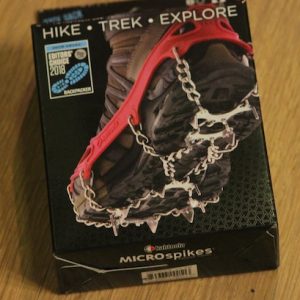 Microspikes are one of the most popular choices of footwear for cold-weather hikers due to their convenience, versatility, and of course, effectiveness. They’re the perfect option for those looking to get into hiking in when ice and snow may be on the trails, as they’re both extremely affordable and built to last.
Microspikes are one of the most popular choices of footwear for cold-weather hikers due to their convenience, versatility, and of course, effectiveness. They’re the perfect option for those looking to get into hiking in when ice and snow may be on the trails, as they’re both extremely affordable and built to last.
How Do They Work?
As the name would suggest, microspikes help you gain traction on slippery terrain by digging in using a large number of small metal spikes attached to chains. As the spikes are evenly distributed over a large portion of your tread, they allow you to walk much more naturally, as you aren’t having to rely on just a few points of balance to get traction.
In addition, they’re extremely easy to use, transport, and maintain! All you have to do is strap them onto your favorite sturdy pair of hiking boots and keep on trekking! If you don’t need them at the moment, however, it’s equally simple to take them back off, and as they’re extremely compact and lightweight, you can just toss them into your pack until you need them again. As they’re made from stainless steel, caring for them is simple. Just rinse and dry them to get off any dirt or grime you picked up from the trail!
To put it simply, microspikes are the perfect entry point for those looking into equipment for tough terrain, but their versatility makes them useful to even the most experienced outdoorsman!
When To Use Microspikes
Because of their much lighter design, microspikes are best suited for hikes that require extra traction on solid but slippery terrain. As such, we recommend using it for conditions like:
- Flat, icy paths
- Inclined or flat paths with packed snow or ice
- Densely packed snow
- Any trail where sections of ice or packed snow may be present. They should be brought even if they may not be needed on most of the trail.
- Microspikes can be placed on boots, but can even be used on trail runners, hiking shoes, or sneakers
- Walking across icy lakes, or shoveling
You should not use microspikes when:
- Climbing
- In deep, loose, or powdery snow (snowshoes tend to be better or this)
What are Crampons?
 Crampons are the much more rugged cousin of microspikes, consisting of an adjustable frame with several large spikes ranging from half an inch to a full inch. Though a bit less versatile than their counterparts, when it comes to mountain climbing and frozen inclines, there’s nothing better.
Crampons are the much more rugged cousin of microspikes, consisting of an adjustable frame with several large spikes ranging from half an inch to a full inch. Though a bit less versatile than their counterparts, when it comes to mountain climbing and frozen inclines, there’s nothing better.
How Do They Work?
Similar to microspikes, crampons are easy to put on and take off, simply attached to your boot by a secure strap. However, they sacrifice the even distribution of traction that microspikes provide to allow for a much better grip on steep surfaces. By using the large toe spikes, you can get a steady foothold in between loose rocks, packed ice, and snow. There are also crampons designed specifically for clipping into mountaineering or backcountry ski boots.
As mentioned earlier, the frame of most crampons is adjustable, meaning that you can ensure a perfect fit for a variety of boot sizes. Because of this, you can make sure that they won’t come loose at a key moment and cause you to lose your foothold. However, due to their more rugged design, they’re naturally heavier than microspikes, and the significantly larger spikes have the potential to tear your clothing or gear, so when you’re trying to put them on, take them off, or store them, be sure to exercise a bit of extra caution.
When To Use Crampons
The larger spikes and adjustability of crampons make them perfect for more difficult tasks, especially those that involve steep inclines. Crampons usually have spikes on the toe side, meaning kicking your toebox into ice is feasible, where it isn’t for microspikes. When inclines require this, crampons tend to excel. Because of this, they’re best for activities and conditions like:
- Climbing
- Icy slopes
- Any slippery inclines that are too steep or icy for microspikes to be effective.
Crampons don’t work for:
- Deep, loose snow
- Long, flat expanses
- Climbers not wearing stiff footwear (sturdy hiking boot, or mountaineering boot). They won’t work with sneakers, trail runners, or hiking shoes.
What are Snowshoes?
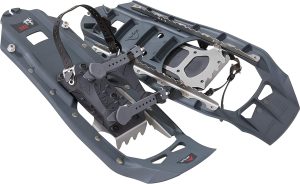 Snowshoes are a piece of equipment that boots strap into in order to increase surface area on snow surface. This increase in surface area provides “flotation” on top of snow for the wearers. Snowshoes come in various sizes and styles, but can be strapped to just about any footwear. Modern snowshoes often have small metal spikes to increase traction on ice.
Snowshoes are a piece of equipment that boots strap into in order to increase surface area on snow surface. This increase in surface area provides “flotation” on top of snow for the wearers. Snowshoes come in various sizes and styles, but can be strapped to just about any footwear. Modern snowshoes often have small metal spikes to increase traction on ice.
How Do They Work?
Much bulkier than other options, snowshoes are specifically designed to allow you to walk in deep, powdery snow. Even with microspikes or crampons, you’ll sink in deep snow, making for a long, cold, and miserable hike. Snowshoes, however, use their large surface area to distribute your body weight much more evenly. As such, the pressure on the snow’s surface won’t be enough to break through, so you won’t sink (as far).
They’re entirely distinct from both microspikes and crampons, meaning that while they’re fit for tasks others can’t accomplish, they’re also limited in that they are not ideal for the same situations as microspikes or crampons.
For example, consider their size and weight. They’re by far the bulkiest and heaviest of the three, meaning you won’t be able to attach, remove, or store them nearly as easily. As such, when you set out on a hike that requires snowshoes, you should have a plan for attaching them to your pack if needed, and recognize that they add a small amount of bulk and weight. Because modern snowshoes also have some additional traction built in, they can provide some traction on non-steep sections of ice, which means they can replace microspikes in some situations.
When To Use Snowshoes
Considering their benefits and drawbacks, we recommend using your snowshoes almost exclusively in situations where their strengths are most necessary and their weaknesses won’t be noticed. This means you’ll want to use them in conditions like:
- Deep snow (our opinion is about 6 inches of snow)
- Loose, powdery snow
- Postholing situations – Often in spring, when snow begins to thaw out, even seemingly hard snow can cause hikers to sink past their knees, where snowshoes would prevent any sinking.
Snowshoes aren’t right for:
- Densely packed snow
- Slippery, icy terrain
- Rocky terrain
- When snow is less than 6 inches deep, it may be easier to walk without snowshoes than with them (this is personal preference)
Expert Note: There are many trails in winter that are so well traveled, that snowshoes aren’t needed. Super popular trails may have 2+ feet of snow, but because so many people walk on it, hikers may prefer microspikes. In these situations, many hikers will bring both, to determine what is best for that particular day. Or, they may use microspikes in the morning when the snow is still hard, and switch to snowshoes later when the temperature warms up the snow.
Crampons vs. Microspikes vs. Snowshoes
Considering the benefits and drawbacks of each, it’s hard to definitively state that one out of the three is the best. While there might not be an objective best, however, different situations demand different equipment, so you just have to figure out which is best for you. In the chart below, we’ve given a few important details about each, such as pros, cons, ideal conditions, and price!
| Crampons | Microspikes | Snowshoes | |
| Materials | Stainless steel or aluminum | Heat treated stainless steel | Aluminum, steel, and plastic or ash wood (traditionally) |
| Best For | – Ice climbing
– Snowy slopes – Ice-covered rocks |
– Level to moderately steep terrain
– Icy paths – Packed snow |
– Deep snow
– Fluffy, powder snow |
| Not Good For | – Deep snow
– Long hikes on level terrain |
– Climbing
– Deep snow |
– Exposed ice
– Packed snow – Rocks |
| Pros | – High-traction fit for any terrain
– Built to be extremely sturdy |
– Compact
– Easy to put on and remove – Low maintenance |
– Available in different widths for various depths of snow |
| Cons | – Relatively heavy
– Can rip gear |
– No toe-spike
– Different sizes required for different boots |
– Relatively bulky
– Increases difficulty of walking |
| Price | $$ | $ | $$ |
Yaktrax Vs Microspikes
In your research, you may have also heard about Yaktrax. We group Yaktrax into the same category is microspikes, however Yaktraks have less extensive traction as they often have no spikes, but simply use steel coils that wrap around rubber to create extra traction. This less aggressive microspike system creates a lighter piece of traction, that grips on snow and ice, just not as aggressively as microspikes. These are therefore not recommended or any incline, but still work well on flat surfaces. Because of the lightweight nature and less aggressive spikes, they are often used for trail running in snowy conditions, or shoveling.
Recommended Winter Footwear & Gear
With all the important information out of the way, you’re probably ready to look into your options, so we’ve listed a few of our favorite options for microspikes, crampons, and snowshoes below!
Kahtoola MICROspikes Traction System
 A solid, versatile option, the Kahtoola Microspikes are designed to be convenient and easy to use, while also remaining extremely durable. They’re made from stainless steel and elastomer, and are designed to function in temperatures as cold as -22 degrees Fahrenheit!
A solid, versatile option, the Kahtoola Microspikes are designed to be convenient and easy to use, while also remaining extremely durable. They’re made from stainless steel and elastomer, and are designed to function in temperatures as cold as -22 degrees Fahrenheit!
Specs:
- Material: Stainless steel
- Weight: 11 oz. (size medium)
- Sizes: S, M, L, XL
- Price: $74.95
Read Our Review On Kahtoola Microspikes | Buy On REI
Yaktrax ICEtrekkers Diamond Grip Traction System
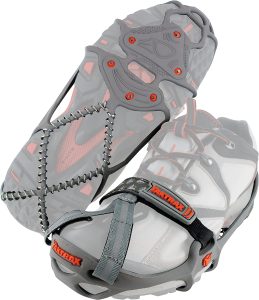 Yaktrax ICEtrekkers are designed to provide a stronger grip than your standard microspikes, with a beaded chain that allows for an extremely high number of gripping surfaces. In addition, they’re the lowest-price microspikes on this list, so you can be sure you’re not only getting quality equipment but getting more than your money’s worth as well.
Yaktrax ICEtrekkers are designed to provide a stronger grip than your standard microspikes, with a beaded chain that allows for an extremely high number of gripping surfaces. In addition, they’re the lowest-price microspikes on this list, so you can be sure you’re not only getting quality equipment but getting more than your money’s worth as well.
Specs:
- Material: Steel alloy
- Weight: 9.6 – 12.8 oz.
- Sizes: S, M, L, XL
- Price: $54.95
Hillsound FlexSteps Traction System
Hillsound FlexSteps are designed to be used in a variety of settings, giving plenty of traction without being clunky or cumbersome. Rather than the traditional chains, these microspikes are attached to a flexible yet durable framework that puts them a cut above the rest.
Specs:
- Material: Stainless steel
- Weight: 13.4+ oz.
- Sizes: XS, S, M, L, XL
- Price: $69.95
Kahtoola K10 Hiking Crampons
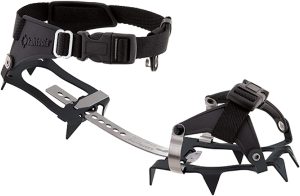 Kahtoola K10 Hiking Crampons are a sort of in-between of microspikes and crampons, providing that extra traction and ruggedness while still maintaining a low profile that won’t get in your way. The steel reinforcement is designed to bend without breaking, allowing you to walk naturally, albeit with a bit of added traction.
Kahtoola K10 Hiking Crampons are a sort of in-between of microspikes and crampons, providing that extra traction and ruggedness while still maintaining a low profile that won’t get in your way. The steel reinforcement is designed to bend without breaking, allowing you to walk naturally, albeit with a bit of added traction.
Specs:
- Material: 4131 Chromoly steel
- Weight: 1 lb. 5.5 oz.
- Sizes: One Size
- Price: $99.95
Black Diamond Contact Crampon
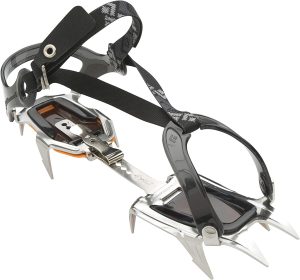 The Black Diamond Contact Crampons are designed to be compact, durable, and versatile, with a flexible toe strap allowing them to be used on most typical hiking shoes and boots. For those who want a slick, polished winter climbing experience, this is the gear for you.
The Black Diamond Contact Crampons are designed to be compact, durable, and versatile, with a flexible toe strap allowing them to be used on most typical hiking shoes and boots. For those who want a slick, polished winter climbing experience, this is the gear for you.
Specs:
- Material: Stainless steel
- Weight: 2 lbs. 3.2 oz.
- Sizes: One Size
- Price: $159.95
Buy On Amazon | See On Black Diamond
Grivel G12 Cramp-O-Matic
 Designed with safety in mind, the Grivel G12 Cramp-O-Matic ensures complete traction in the snow, and can be adjusted by hand, so any minor fixes can be done on the fly. With 12 large spikes, you’ll be able to get a solid, even grip while climbing.
Designed with safety in mind, the Grivel G12 Cramp-O-Matic ensures complete traction in the snow, and can be adjusted by hand, so any minor fixes can be done on the fly. With 12 large spikes, you’ll be able to get a solid, even grip while climbing.
Specs:
- Material: Chromoly steel
- Weight: 2 lbs.
- Sizes: One Size
- Price: $151.25
MSR Evo Trail Snowshoes
 Many winter hikers will swear by the MSR Evo Trail Snowshoes, and for good reason! Not only do they allow you to walk in deep snow, but provide options to increase traction as well. Best of all, they’re extremely durable, so as long as you take care of them, you may never need another pair of snowshoes!
Many winter hikers will swear by the MSR Evo Trail Snowshoes, and for good reason! Not only do they allow you to walk in deep snow, but provide options to increase traction as well. Best of all, they’re extremely durable, so as long as you take care of them, you may never need another pair of snowshoes!
Specs:
- Material: Plastic
- Weight: 3 lbs. 7 oz.
- Sizes: 22 in.
- Price: $149.95
MSR Lightning Ascent Snowshoes
 The MSR Lightning Ascent Snowshoes provide everything you need and then some, with a near-indestructible build, a large number of grip points, and freeze-proof straps that will ensure they stay perfectly in place. With these, you’ll be able to dig in your heels and keep moving, even in the most challenging conditions.
The MSR Lightning Ascent Snowshoes provide everything you need and then some, with a near-indestructible build, a large number of grip points, and freeze-proof straps that will ensure they stay perfectly in place. With these, you’ll be able to dig in your heels and keep moving, even in the most challenging conditions.
Specs:
- Material: Aluminum
- Weight: 4 lbs. – 4 lbs. 12 oz.
- Sizes: 22 in., 25 in., 30 in.
- Price: $349.95
Buy On REI (Men’s) | Buy On REI (Women’s)
Chinook 80002 Trekker Snowshoes
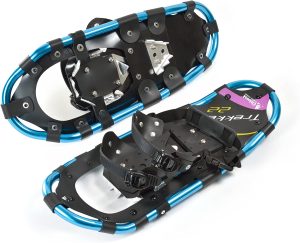 The Chinook 80002 Trekker Snowshoes boast a sleek, ergonomic design that’s both effective and aesthetically pleasing, and are designed to stand up to the elements. In addition, they’re designed to be much more portable than the average snowshoe, with an included carrier bag. If you’re planning on a hike that only requires snowshoes in certain parts, these are the perfect option.
The Chinook 80002 Trekker Snowshoes boast a sleek, ergonomic design that’s both effective and aesthetically pleasing, and are designed to stand up to the elements. In addition, they’re designed to be much more portable than the average snowshoe, with an included carrier bag. If you’re planning on a hike that only requires snowshoes in certain parts, these are the perfect option.
Specs:
- Material: Aluminum
- Weight: 6 lbs. 2.7 oz.
- Sizes: 22 in.
- Price: $148.92
Max DesMarais is the founder of hikingandfishing.com. He has a passion for the outdoors and making outdoor education and adventure more accessible. Max is a published author for various outdoor adventure, travel, and marketing websites. He is an experienced hiker, backpacker, fly fisherman, backcountry skier, trail runner, and spends his free time in the outdoors. These adventures allow him to test gear, learn new skills, and experience new places so that he can educate others. Max grew up hiking all around New Hampshire and New England. He became obsessed with the New Hampshire mountains, and the NH 48, where he guided hikes and trail runs in the White Mountains. Since moving out west, Max has continued climbed all of the Colorado 14ers, is always testing gear, learning skills, gaining experience, and building his endurance for outdoor sports. You can read more about his experience here: hikingandfishing/about
